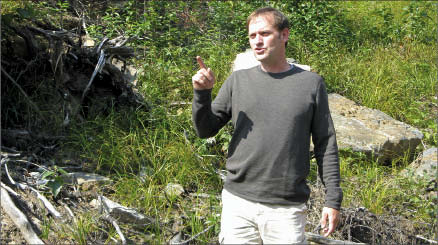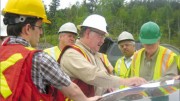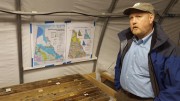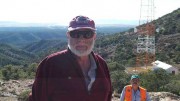In the 11 years David Palmer has spent working in remote, infrastructure-challenged corners of northern Ontario and Quebec, the geologist has never had the luxury of stepping out of his hotel and being on-site within 15 minutes. Until Borden Lake, that is.
A logging road directly off provincial highway 101 takes Palmer straight to his drill site, 12 km outside the tiny town of Chapleau. “It’s the best access I’ve ever had,” the president and chief executive of Probe Mines (PRB-V) tells a group of mining analysts, investors and investment bankers on a tour of the company’s Borden Lake property. “You can hear the drills from the highway.”
Timmins is two hours to the east, Wawa is one hour and 15 minutes to the west, and hydropower is just one kilometre away. Ironically, though, it is one of the least-explored parts of Ontario.
“There have probably been thousands of geologists passing through here between Wawa and Timmins, and yet it’s been so underexplored,” Palmer says, adding that there are four gold mines within a 150-km radius. Trelawney Mining and Exploration‘s (TRR-V) Coté Lake deposit is 110 km to the southeast, Barrick Gold‘s (ABX-T, ABX-N) past-producing Renabie mine is 70 km to the northwest, Prodigy Gold‘s (PDG-V) Magino mine is 100 km to the northwest and Lake Shore Gold‘s (LSG-T) Timmins mine is 140 km to the northeast.
Borden Lake lies within a folded belt of Timiskaming-age, 2.6-billion-year-old meta-sediments in the Kapuskasing structural zone (KSZ), an area that Palmer says has been overlooked for generations, but which he believes is likely to serve-up the next big gold discovery in the province.
“The KSZ is an area no one has ever thought to look at,” Palmer continues, reasoning that prospectors and geologists were more confident looking at the lower metamorphic-grade rocks in the greenstone belts of Timmins and Kirkland Lake.
“The only logical reason I see for the lack of exploration in the KSZ is the higher metamorphic grade,” he explains. “It is possible that people feel the higher pressure-temperature regime is destructive for primary gold deposits. Perhaps Borden Lake was preserved because it is at the very end of the KSZ, and wasn’t subjected to these pressure-temperature conditions.”
Whatever the reason, it turns out to have been a blessing in disguise. There has been little work done in the area, which leaves Probe with a blank canvas.
The project came out of left field. Near the end of 2010, Palmer and his team of geologists were busy working on the company’s 100%-owned Black Creek chromite deposit, two hours by air north of Thunder Bay. The deposit lies in the James Bay Lowlands’ Ring of Fire, and is sandwiched between Cliffs Natural Resources‘ (CLF-N) two large chromite deposits, Black Thor and Big Daddy.
But when assay results from Borden Lake trickled back in November 2010 showing gold mineralization in every drill hole, Palmer shifted gears, making Borden Lake his number one priority.
The company completed a National Instrument 43-101 compliant resource in less than nine months, and plans to update it before the end of the year. The new resource should confirm what Palmer already suspects: that Borden Lake has excellent potential to host a near-surface, low-grade, bulk tonnage deposit. So far the deposit has been traced over an area stretching 1,700 metres in length and up to 200 metres in width, while running a 340-metre depth.
Indicated resources stand at 11.61 million tonnes averaging 0.8 gram gold per tonne for 305,000 oz. contained gold, with inferred resources adding 169.32 million tonnes averaging 0.69 gram gold for 3.76 million oz. contained gold.
The deposit also contains 323,000 oz. silver in the indicated category and 5.02 million oz. silver in the inferred, both at an average grade of 0.9 gram silver per tonne.
The initial resource estimate is based on a 0.3-gram-per-tonne cut-off grade and 78 diamond drill holes. It excludes three satellite gold zones.
Probe has completed a total of 115 holes, and since January 2011 has drilled more than 25,000 metres with two drill rigs. The company is in the queue for more rigs.
The deposit is an outcrop discovery under thin overburden that comes to surface all along strike. Mineralization is characterized by higher-grade zones occurring within a broad, lower-grade envelope hosted by meta-sediments.
“Most gold deposits don’t show up in airborne electro-magnetic surveys, but this one does,” Palmer explains. “The induced polarization signature is distinctive, too.”
“You’ll see the sulphides if you look for them but they don’t jump out at you,” he adds, while showing core to his visitors.
Understanding the deposit and how it came to be is proving a challenge, however.
What Palmer does know is that he has a clean sulphide deposit without base metals, arsenic or arsenopyrite. The deposit demonstrates thick planes of mineralization without folding or faulting, and without quartz veining. There is little displacement and the same lithologies exist all along strike, while the mineralization is very consistent on strike and at depth. “It doesn’t waffle. The mineralization is consistent throughout,” he says. “We can pick up a high-grade zone right through the deposit, and that’s one reason why Micon said we didn’t need to cap the grades.”
But Palmer and his colleagues are still scratching their heads about the mineralization and concede they can’t take anything for granted. That’s why the company is blanketing the ground with geophysics. “You have to sample everything because sometimes it surprises you,” he explains. “We recently found gold in the granite, which was unexpected.”
Palmer is quick to admit that he has a lot to learn about how the mineralization got there. “There are no obvious hydrothermal systems that brought it in. The porphyry isn’t mineralized,” he says. “It’s biotite gneiss, pyrrhotite, pyrite and amphibolite in a meta-sedimentary belt. There’s no clear correlation between the gold and anything.”
“From the point of view of gold exploration, you’d never put these rocks in a sample bag,” he adds. “It’s a puzzle. But the bottom line is it’s there, and in the numbers you need to produce it.”
Palmer is hoping metallurgical results due out soon will provide some clues.
“If it is pre-metamorphic it should be recrystallized,” he reasons. “At one time these rocks were down twenty kilometres,
so everything was recrystallized. And we’re hoping the gold was recrystallized too, which should result in a coarser grain size and aid in recovery.”
Mark Raguz, an analyst at Pinetree Capital, which holds some of Probe’s stock, noted that results from the initial metallurgical test work “should be a revaluation catalyst for the stock, if the grind size and recovery are positive.”
In the meantime Probe is pressing ahead with grassroots exploration, and in recent months has been getting between 0.3 gram gold per tonne and 3.4 grams gold per tonne from grab samples taken near its outcrop discovery.
“There’s a lot of potential on the belt for new targets,” Palmer says, explaining that Timiskaming sediments often show a spatial association with large-scale Archean lode gold deposits, such as those found in the mining camps of Timmins, Kirkland Lake, Hemlo and Red Lake. “Between now and Christmas we’re going to make some headway on exploration.”
In September Probe released more assay results from its drill program demonstrating significant intervals of gold mineralization, including a high-grade zone averaging 10.9 grams gold over 7 metres, and carrying a one-metre interval grading 57 grams gold.
As Palmer sees it, there are few, if any, stumbling blocks to advancing the project. Environmental permitting, which is expected to take a year, is already underway, as are discussions with the thre
e First Nations communities near Chapleau.
Last month Probe signed a memorandum of understanding with the Brunswick House, Chapleau Cree and Chapleau Ojibwe First Nations communities, and agreed to negotiate an Impact Benefit Agreement should the gold project proceed to production.
Probe has also committed to training, communication and business development with the First Nations, agreeing to give 50,000 common shares of the company to each of the three groups vesting over a period of 18 months.
“Our work has received a lot of support here,” Palmer says, noting that some of the First Nations are talking about setting up a company that would offer services to the mining company.
The residents of Chapleau could use the work. In its heyday, the small settlement in the Cochrane township within the Martel forest boasted three lumber mills and a population of 5,000. Today the town is home to 2,500 people and just one lumber mill.
One of the big question marks analysts seem to have concerns whether Probe can successfully acquire all of the land that it will need to take the project forward. While Palmer says the company has “got all the critical pieces” of land that it needs, he admits that Probe is holding discussions with several private owners, including a private forestry company, which owns between 20 sq. km and 30 sq. km of land to the east of the project. It has already completed one deal with the company and hopes to negotiate others. But Palmer is all about the soft sell. “We want to develop our relationship with them,” he says. “We don’t want to pressure people.”
But Probe Mines is more than Borden Lake, and the company has several other assets that store value, including its Black Creek chromite deposit in the McFaulds Lake and Ring of Fire areas in northern Ontario.
Black Creek extends into the Black Thor claim owned by Cliffs Natural Resources, and owing to a small displacement fault, it is also 200 metres away from Cliffs’ other large chromite deposit, Big Daddy. Cliffs acquired junior explorer Spider Resources in 2010 to take a majority interest, now 73.5%, in the Big Daddy deposit, and has been the operator since March. KWG Resources (KWG-V) owns the remainder.
“We’re right between the two,” Palmer says. “Interestingly enough, the horizon is almost continuous between Black Thor, Black Creek and Big Daddy . . . Black Creek is essentially the southwest extension of Black Thor. The chromite deposits tend to occur as large lenses, but all seem to form a relatively continuous chromite horizon.”
That’s good news for Probe, because Black Thor is the largest known deposit of chromite in North America, with inferred resources of 69.5 million tonnes at a grade of 31.9% chromite. Big Daddy contains an indicated resource of 23.2 million tonnes averaging 40.66% chromite, and inferred resources equal 16.3 million tonnes averaging 39.09% chromite. Black Creek has measured and indicated resources of 8.65 million tonnes averaging 37.41% chromite, and inferred resources of 1.6 million tonnes with 37.78% chromite.
Cliffs plans to develop Black Thor first, given that it is thicker and closer to surface than the Big Daddy deposit. But it will have to spend hundreds of millions of dollars to build the road, rail and power infrastructure that it will need. The deposits are more than 300 km north of the province’s existing road and rail networks. In a project update earlier this year, Cliffs announced that if prefeasibility and feasibility studies prove favourable, production at Black Thor could start as early as 2015.
That makes Probe’s Black Creek deposit even more strategic. “The value of Black Creek is going up as they get closer to building the infrastructure,” Palmer says. “It could be worth somewhere between $100 million and $125 million.”
In August 2010 Probe initiated a shareholder rights plan.
Apart from Black Creek, Probe has an option-joint venture agreement with Lake Shore Gold on its West Timmins gold project in the Bristol township, which surrounds Lake Shore’s Timmins mine, a 1 million-plus oz. gold deposit. It is also exploring its Cree Lake gold project in Ontario’s Swayze greenstone belt, under option from Mantis Mineral.
Finally, Probe holds a 5% net smelter return royalty (NSR) interest on claims covering a portion of the Goldex deposit owned by Agnico-Eagle Mines (AEM-T, AEM-N), located just 5 km west of Val-d’Or, Quebec. “It’s not something to build a royalty company on, but it’s a nice thing to have,” Palmer says.
Agnico-Eagle started production at the underground mine in 2008, bringing Probe’s NSR a step closer to becoming a revenue stream for the company. The low-grade, bulk tonnage deposit hosts measured reserves of 1.6 million oz. gold.
Probe trades at $2.10 per share, within a 52-week range of 69¢ and $2.38 per share. The company has 56.6 million shares outstanding and 71.8 million shares fully diluted.
Newsletter writer John Kaiser wrote on Oct. 13 that he believes the stock price could move up to $3 per share during the next couple of months, and at least $4 per share during the first quarter of 2012.






Be the first to comment on "Who knew there was gold in Chapleau?"